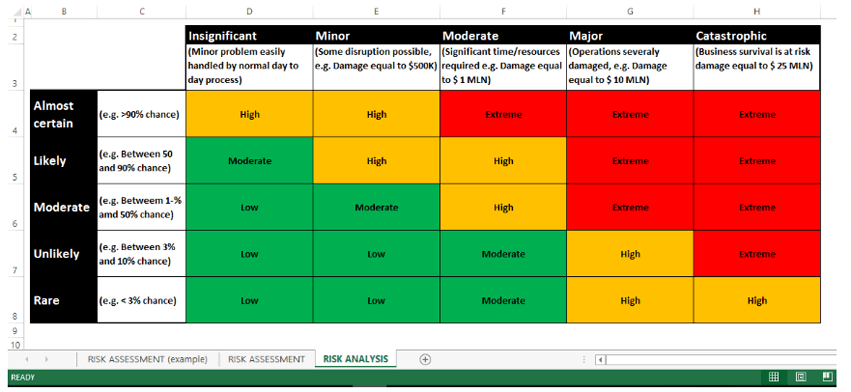
Click the button to start reading
Preventing Disaster: 9 Risk Mitigation Strategies and Examples for Your Business
The recent failure of Silicon Valley Bank (reportedly the largest institutional failure since the 2008 financial crisis!) is a stark reminder of one thing. When it comes to business management, it’s better to be safe than sorry.
With the increasing complexity of global events beyond our control, it’s crucial to have robust risk management techniques in place.
In this blog post, we’ll define risk mitigation strategies and share examples of risk mitigation in project management to help you implement better practices and safeguard your business.

What are risk mitigation strategies?
Risk mitigation strategies are proactive measures designed to reduce or minimize the impact of potential risks.
These strategies help to identify, assess, and prioritize potential risks and then take appropriate actions to either avoid, transfer, reduce, or accept the risks.
Here’s a simpler explanation.
Risk mitigation strategies are like a safety net for a tightrope walker. The net provides a cushion in case the walker loses their balance. In the same way, risk mitigation strategies in project management provide a safety cushion against potential risks.
The net doesn’t prevent the walker from falling, but it minimizes the impact and allows them to recover. Similarly, risk mitigation strategies don’t eliminate risks, but they minimize the impact and allow organizations to recover more quickly.
Also, the net requires careful planning and preparation to ensure it’s in the right place and strong enough to do its job, just as risk mitigation strategies require careful planning and preparation to be effective.
Managing risks step-by-step
Managing risks involves a step-by-step process that involves the following key phases:

Image source: Project-Management.com
Step 1: Identify the risks (What could go wrong?)
You should identify risks by analyzing the internal and external factors that could affect your project or organization. A few strategies that are relevant at this stage are brainstorming, reviewing historical data, and conducting risk assessments.
Step 2: Assess the risks (What will be the impact?)
The second step is to assess the likelihood and impact of each risk. This involves evaluating the probability of the risk occurring and the potential impact it could have on the project.
By completing this step, you focus resources and attention on the risks that are most critical. Here’s a chart to help you with this task:

Image source: AllBusinessTemplates.com
Step 4: Develop risk mitigation strategies (What should be done?)
Next, you should develop risk mitigation strategies. A comprehensive risk mitigation plan outlines the strategies and procedures for managing risks throughout the project. This also involves assigning responsibilities for bringing the plan to life.
Step 5: Implement risk mitigation strategies
Even the best risk mitigation plan is useless if you fail to put it into action. At this stage, you should execute the identified actions to reduce or eliminate the potential risks.
Step 6: Monitor and review (Did you identify the risks correctly, and were your strategies effective?)
Finally, it’s important to monitor and review the effectiveness of risk mitigation strategies in project management. Track progress, evaluate the success of the strategies, and make adjustments as needed.

Responding to risk: Most effective risk mitigation strategies in project management (with examples)
Clear and well-thought-out risk mitigation techniques are crucial to ensuring the success of a project.
Here are some of the most effective strategies in project management. For each strategy, you’ll get an example to clearly understand what the technique is all about. Without a doubt, learning from risk mitigation strategies examples can help you stay ahead of the curve and avoid common pitfalls.
1. Risk acceptance: Taking calculated risks
Imagine you’re going on a hike. Before you start, you might check the weather report and plan accordingly. But what if the report says there’s a chance of rain? Do you cancel the hike or risk getting wet?
That’s essentially what risk acceptance strategy is all about. It’s a deliberate choice to accept a certain level of risk rather than trying to eliminate it entirely.
In project management, risks are an unavoidable part of any venture. Instead of trying to avoid all potential risks, project managers, who adopt a risk acceptance strategy, recognize that some level of risk is necessary to achieve their goals.
Example of a risk acceptance strategy
A small business owner might choose to accept the risk of losing customers due to a price increase rather than lowering prices and accepting a lower profit margin. The owner might determine that the potential impact of losing some customers is less than the cost of reducing prices.
2. Risk avoidance: Bypassing the potential risks
Sometimes, the best way to deal with risk is to simply avoid it altogether. It’s like deciding not to go on a hike if you know there’s a high chance of a thunderstorm. This approach involves identifying potential risks and taking steps to eliminate or bypass them.
In project management, successful risk avoidance requires a balance between caution and strategic thinking. You should carefully analyze potential risks and assess the costs and benefits of different options. Afterwards, you should make informed decisions based on the company’s specific needs and objectives.
Example of a risk avoidance strategy
An engineering firm might avoid using new, untested technology, instead opting for a proven, more traditional technology. This can help to avoid the risk of the new technology not working properly and causing delays or other issues.
3. Risk transfer: Shifting the responsibility to another party
Among risk mitigation strategies, examples may also include risk transfer.
In the business world, risk transfer is a common strategy used to mitigate the financial impact of potential risks. It involves shifting the risk to another party through contracts, insurance policies, or other agreements.
Example of a risk transfer strategy
A construction company might transfer the risk of an accident or injury on a job site to an insurance company by purchasing liability insurance. This transfers the financial responsibility for any claims or damages resulting from an accident or injury to the insurance company.
4. Collaborative risk sharing: Working with partners for mutual benefit
Collaborative risk-sharing is like splitting the cost of moving expenses with your friend who’s helping you move. You’re both sharing the risk and the reward.
One of the key benefits of collaborative risk-sharing is that it allows companies to tap into the expertise and resources of their partners. By working together, they can leverage each other’s strengths and share the financial burden of potential risks.
Example of collaborative risk-sharing
A software development team might share the risk of a project delay with a client. They agree to provide regular updates and involve the client in the development process. This helps to identify any potential issues or delays early and address them together.
5. Buffering strategies: Creating the cushion that absorbs the impact of a risk event
Think of this strategy like wearing a helmet when you ride a bike. Surely, it doesn’t prevent the risk of falling, but it can greatly reduce the impact of a fall.
Consider putting measures in place to mitigate the potential impact of the risk for your project. You may choose to build in extra time, budget, or resources to address the risk if it occurs. By doing this, you increase the chance of minimizing the impact of the risk and keeping the project on track.
Examples of buffering strategies
Companies might maintain a cash reserve or line of credit to provide a financial buffer in case of unexpected expenses or revenue shortfalls. They might also implement redundant systems or processes to ensure that critical operations can continue even in the event of a failure or outage.
Another example of a buffering strategy is diversification. By diversifying their products, services, or investments, companies can spread their risk across multiple areas and reduce their exposure to any one particular risk. For instance, a company that relies heavily on one supplier for a critical component may choose to work with multiple suppliers to ensure a steady supply chain.
6. Risk testing and simulation: Predicting the unexpected
Essentially, this strategy involves creating simulations or models that can predict the potential impact of a risk event.
However, risk testing and simulation aren’t foolproof. It relies heavily on assumptions that may not always accurately reflect real-world scenarios. As such, it’s important to use risk testing and simulation as just one tool in a comprehensive risk management strategy.
Example of a risk testing and simulation
A company might use risk testing and simulation to evaluate the potential impact of a cyberattack on its systems. By creating a simulation that models various types of attacks and their potential impact on the business, the company can identify vulnerabilities and implement mitigation strategies to reduce the risk of an actual attack.
7. Risk prioritization: Understanding the potential severity of a risk
Risk prioritization involves ranking risks based on their importance or significance to the organization or project. Your task is to weigh factors such as the likelihood and potential impact of the risk, as well as the organization’s goals and priorities.
Example of a risk quantification strategy
Let’s say a company relies on a complex network of suppliers to produce its products. They identify several potential risks, including supplier bankruptcy, supplier quality issues, and disruptions in the transportation network. To prioritize these risks, they consider the potential impact of each risk on their supply chain, as well as the likelihood of each risk occurring. Based on this analysis, they determine that supplier quality issues pose the highest risk to their supply chain. They then allocate resources and develop mitigation strategies accordingly, with a greater emphasis on addressing the higher-priority risk first.
8. Delaying risk: Deciding when and how to effectively defer potential risks
Another risk mitigation strategy example is to postpone a risk. This means delaying a decision or action that could create a potential risk until more information is available. When the potential risk is uncertain or difficult to quantify, you’ll find this strategy quite useful.
Example of delaying risk
A pharmaceutical company might defer a decision to invest in a new drug until additional data is available on potential side effects or risks associated with the drug. This allows the company to make a more informed decision based on the available data.
9. Digitization of risk management: leveraging the power of digital tools
The digitization of risk management is the process of using digital tools and technologies to mitigate risks more efficiently. You may decide to use a range of tools, including data analytics, machine learning, artificial intelligence, and cloud computing.
By the way, according to Mckinsey’s observations, digital risk initiatives have the potential to cut down operating costs for risk activities by 20 to 30 percent.
Example of digitization of risk management
A retail company might use digital tools to identify patterns that may indicate potential risks. This will allow them to take proactive steps to mitigate those risks before they become major issues.
Summing it up!
Effective risk mitigation strategies in project management aren’t just about avoiding potential disasters. They’re about empowering your business to take bold risks, innovate, and achieve your goals with confidence.
By leveraging the right risk mitigation strategies, you can reduce the fear of failure and increase the chances of success. So don’t wait until it’s too late. Invest in developing and implementing robust risk mitigation strategies today and unlock the full potential of your business tomorrow.
















